文库高一英语必修一《Unit1Friendship》教案
高中英语必修1第一单元课文friendship课件
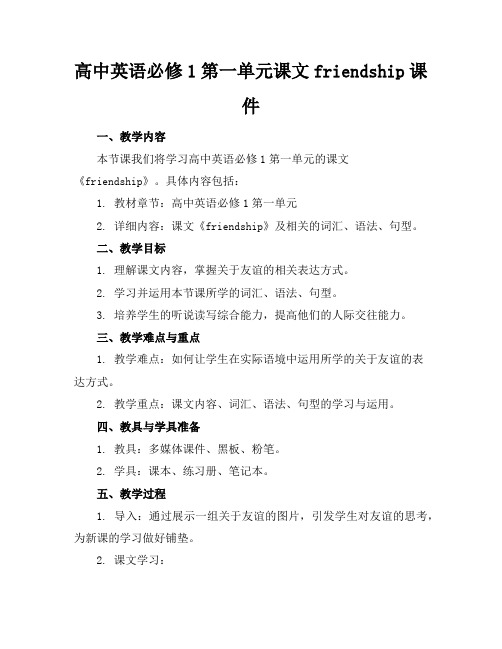
高中英语必修1第一单元课文friendship课件一、教学内容本节课我们将学习高中英语必修1第一单元的课文《friendship》。
具体内容包括:1. 教材章节:高中英语必修1第一单元2. 详细内容:课文《friendship》及相关的词汇、语法、句型。
二、教学目标1. 理解课文内容,掌握关于友谊的相关表达方式。
2. 学习并运用本节课所学的词汇、语法、句型。
3. 培养学生的听说读写综合能力,提高他们的人际交往能力。
三、教学难点与重点1. 教学难点:如何让学生在实际语境中运用所学的关于友谊的表达方式。
2. 教学重点:课文内容、词汇、语法、句型的学习与运用。
四、教具与学具准备1. 教具:多媒体课件、黑板、粉笔。
2. 学具:课本、练习册、笔记本。
五、教学过程1. 导入:通过展示一组关于友谊的图片,引发学生对友谊的思考,为新课的学习做好铺垫。
2. 课文学习:(1)听录音,让学生初步感知课文内容。
(2)让学生跟随录音朗读课文,熟悉课文内容。
(3)逐段讲解课文,分析词汇、语法、句型。
3. 例题讲解:(1)针对本节课的重点词汇、语法、句型进行讲解。
(2)结合实际语境,让学生进行例题练习。
4. 随堂练习:(1)让学生用所学的表达方式描述自己与朋友之间的友谊。
(2)分组进行对话练习,提高学生的口语表达能力。
六、板书设计1. 《friendship》2. 重点词汇、语法、句型3. 课文结构及关键信息七、作业设计1. 作业题目:(2)根据课文内容,用所学的表达方式写一篇关于友谊的短文。
2. 答案:(1)真正的友谊就像健康的身体;只有在失去之后,人们才会意识到它的价值。
八、课后反思及拓展延伸1. 反思:关注学生的学习效果,针对学生的掌握情况,调整教学方法与策略。
2. 拓展延伸:(1)让学生搜集关于友谊的名言、谚语,进行分享。
(2)组织学生进行“友谊的力量”主题演讲比赛,提高学生的英语表达能力。
重点和难点解析1. 教学目标中的“理解课文内容,掌握关于友谊的相关表达方式”。
高中英语必修一Unit1《Friendship》教学课件

4.go through
5.set down
合计
参加;加入
love (with) 相爱;爱上
经历;经受
记下;放下;登记
6.get along/on with
与……相处;进展
基础自主梳理
be+形容词+介词
7.get/be tired
of
对……厌烦
其他
8.
on purpose 故意
9.
at
dusk 在黄昏时刻
night
face to face…
……这是我一年半以来第一次
目睹夜晚……
记公式(公式这样记)
仿句子(高考这样考)
It is/was the first
timethat+sb+have(has
)/had done sth. 某人第
一次做某事。
2.这将是你第二次帮我了。
It will be the second time
2. 表示“能力;力量”的名词荟萃
①power 能力;力量;权力 ②ability 能力 ③competence 能力;胜任
④energy 精力;能源 ⑤force 武力 ⑥strength 力量
基础自主梳理
3. dis-否定前缀词汇大荟萃
①disagree vi.不同意 ②disappear vi.消失
__________________that
I'm
him again
particularly interested in this
position.
基础自主梳理
背句型(课本这样讲)
2.… it was the first timein a
人教版高中英语必修一 Unit1 Friendship 教案
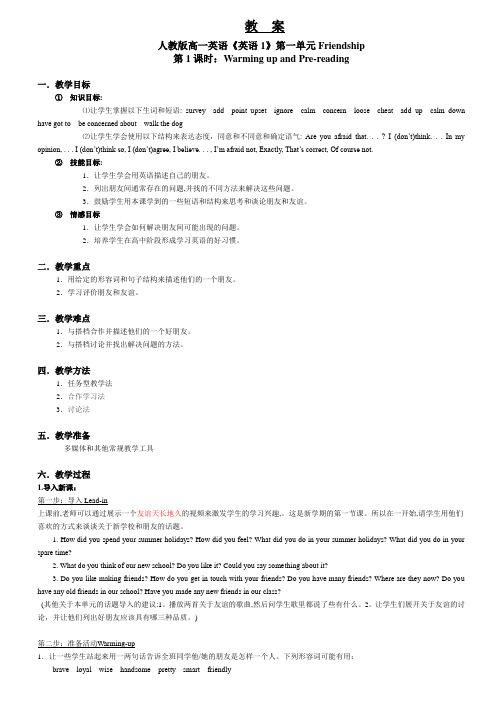
教案人教版高一英语《英语1》第一单元Friendship第1课时:Warming up and Pre-reading一.教学目标①知识目标:⑴让学生掌握以下生词和短语: survey add point upset ignore calm concern loose cheat add up calm down have got to be concerned about walk the dog⑵让学生学会使用以下结构来表达态度,同意和不同意和确定语气: Are you afraid that. . . ? I (don’t)think. . . In my opinion, . . . I (don’t)think so, I (don’t)agree, I believe. . . , I’m afraid not, Exactly, That’s correct, Of course not.②技能目标:1.让学生学会用英语描述自己的朋友。
2.列出朋友间通常存在的问题,并找的不同方法来解决这些问题。
3.鼓励学生用本课学到的一些短语和结构来思考和谈论朋友和友谊。
③情感目标1.让学生学会如何解决朋友间可能出现的问题。
2.培养学生在高中阶段形成学习英语的好习惯。
二.教学重点1.用给定的形容词和句子结构来描述他们的一个朋友。
2.学习评价朋友和友谊。
三.教学难点1.与搭档合作并描述他们的一个好朋友。
2.与搭档讨论并找出解决问题的方法。
四.教学方法1.任务型教学法2.合作学习法3.讨论法五.教学准备多媒体和其他常规教学工具六.教学过程1.导入新课:第一步:导入Lead-in上课前,老师可以通过展示一个友谊天长地久的视频来激发学生的学习兴趣,。
这是新学期的第一节课。
所以在一开始,请学生用他们喜欢的方式来谈谈关于新学校和朋友的话题。
1. How did you spend your summer holidays? How did you feel? What did you do in your summer holidays? What did you do in your spare time?2. What do you think of our new school? Do you like it? Could you say something about it?3. Do you like making friends? How do you get in touch with your friends? Do you have many friends? Where are they now? Do you have any old friends in our school? Have you made any new friends in our class?(其他关于本单元的话题导入的建议:1。
人教版高中英语必修一教案Unit 1 Friendship (含答案)
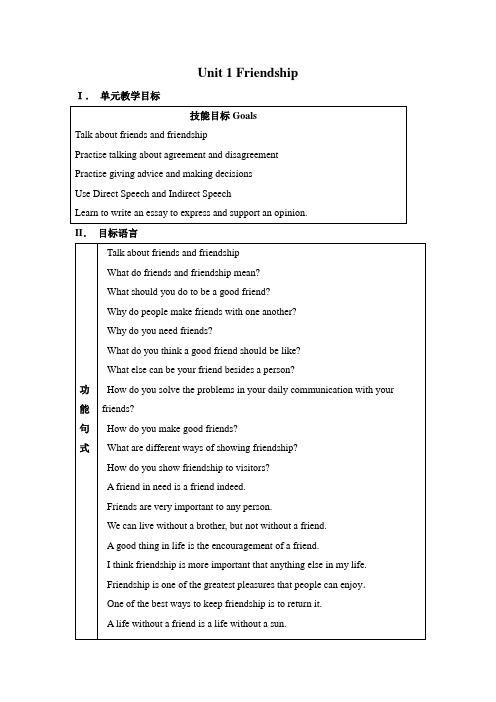
Unit 1 Friendship I.单元教学目标II.目标语言III. 教材分析和教材重组1. 教材分析本单元以Friend和Friendship为话题,旨在通过单元教学使学生通过讨论什么是好朋友,什么是真正的友谊,如何交友和保持友谊等问题,使学生树立正确的交友观。
并针对日常交友过程中经常遇到的实际问题,指导学生发表自己的见解和看法,通过进一步讨论提供有效的解决方案。
并能就此以编辑的身份写出指导信,对相关谚语写出观点明确、论证有力的短文。
1.1 Warming Up以调查问卷的形式,通过对学生在日常交友过程中所遇到的五个问题,展开调查,使学生对是否擅长交友做出评价,激发学生对本单元的中心话题产生兴趣;同时也使教师本单元的授课更具有针对性,从而有效地帮助学生树立正确的交友观。
1.2 Pre-Reading通过四个问题引导学生讨论交友的重要性以及自己心目中好朋友的概念和标准,并使学生认识到不仅人与人,人与物(如日记)也可以成为好朋友。
继续探究并树立正确交友观,并为阅读作好了准备。
1.3 Reading讲述第二次世界大战的纳粹统治时期,犹太人Anne一家过着滇沛流漓,与世隔绝的生活。
Anne在孤独中只能以日记Kitty 为友,倾诉衷肠,伴其渡过两年的逃亡生涯。
控诉了纳粹党的残暴统治给犹太人民带来了深重的灾难,并以日记的形式表达了以主人公Anne为代表的全世界人民憎恨战争渴望和平的共同心愿。
学生学习了新的词汇、句型,提高了阅读水平。
文中选用了主人公的一篇日记,使学生进一步感受到了挚友的可贵,对主人公内心世界的描写有了更深刻的理解。
1.4 Comprehension 设计了三种题型。
其中前两个是考查学生对READING文章细节内容的理解,最后一题是开放性问题,学生可以在更深入理解主人公内心世界的基础上各抒己见,使学生养成勤于思考勇于探究的良好的学习习惯,现时也培养了学生的想象力,进一步提高了阅读水平。
人教版高一英语必修一《Unit1 Friendship》说课稿

人教版高一英语必修一《Unit1 Friendship》说课稿1. 教材信息•课时数:2课时•教材版本:人教版•适用年级:高一•课题:Unit 1 Friendship•单元内容:词汇、语法、听说读写2. 课时目标通过本课的学习,学生将能够:•了解友谊的重要性及如何建立和维护友谊;•学会运用正确的语法结构来描述个人经历与感受;•提高听说读写能力;•提高团队合作能力和表达能力。
3. 课前准备3.1 教师准备•教材:《人教版高一英语必修一》课本 Unit 1 Friendship•多媒体设备:投影仪、电脑•板书工具:彩色马克笔、擦布3.2 学生准备•学生已预习并了解本课的单元主题和词汇;•学生准备了笔和纸。
4. 教学过程4.1 导入新课 (10分钟)•利用投影仪播放一段关于友谊的短视频,引发学生对友谊的思考和讨论。
•提问一些问题激发学生的兴趣,如:你觉得友谊对人的生活重要吗?你曾经遇到过怎样的好朋友?他们对你有什么样的影响?请和同桌讨论一下。
4.2 新课讲解 (20分钟)•向学生介绍本单元的主题:Friendship(友谊)。
•通过示范和解释演示本单元的词汇,如friend(朋友)、trust(信任)、support(支持)等,以及常用短语如make friends(交朋友)、build up friendships(建立友谊)等。
•引导学生思考并讨论友谊对个人成长的重要性以及如何建立和维护友谊。
4.3 语法与写作练习 (30分钟)•通过示范和解释演示本单元的语法结构,如使用过去完成时来描述个人经历和感受。
•提供一些例句,让学生观察并尝试使用过去完成时来描述自己的经历和感受。
•让学生进行小组活动,在小组内分享自己的经历和感受,并使用过去完成时进行描述。
鼓励学生进行互动和合作,提高口语表达能力和团队合作能力。
•引导学生将小组活动中的一些经历和感受写成短文,并进行班内展示,提高写作能力和表达能力。
4.4 听力和口语训练 (30分钟)•通过播放录音和提供听力材料,让学生进行听力训练。
新人教版必修一unit 1《friendship》friendship in hawaii教学设计(精品).doc
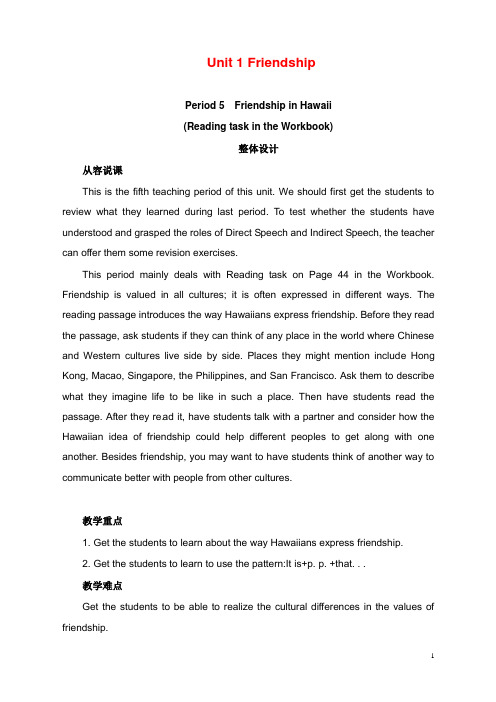
Unit 1 FriendshipPeriod 5Friendship in Hawaii(Reading task in the Workbook)整体设计从容说课This is the fifth teaching period of this unit. We should first get the students to review what they learned during last period. To test whether the students have understood and grasped the roles of Direct Speech and Indirect Speech, the teacher can offer them some revision exercises.This period mainly deals with Reading task on Page 44 in the Workbook. Friendship is valued in all cultures; it is often expressed in different ways. The reading passage introduces the way Hawaiians express friendship. Before they read the passage, ask students if they can think of any place in the world where Chinese and Western cultures live side by side. Places they might mention include Hong Kong, Macao, Singapore, the Philippines, and San Francisco. Ask them to describe what they imagine life to be like in such a place. Then have students read the passage. After they re ad it, have students talk with a partner and consider how the Hawaiian idea of friendship could help different peoples to get along with one another. Besides friendship, you may want to have students think of another way to communicate better with people from other cultures.教学重点1. Get the students to learn about the way Hawaiians express friendship.2. Get the students to learn to use the pattern:It is+p. p. +that. . .教学难点Get the students to be able to realize the cultural differences in the values of friendship.教学方法[1. Task-based teaching and learning2. Cooperative learning3. Discussion教具准备The multimedia and other normal teaching tools三维目标Knowledge aims:1. Get the students to learn about the way Hawaiians express friendship.2. Get the students learn to use the patter n:It is+p. p. +that. . .Ability aims:Get the students to be able to realize the cultural differences in the values of friendship in addition to its importance in all cultures.Emotional aims:1. Get the students to share different opinions on friendship in different cultures.2. Develop their ability to deal with and cooperate with others.教学过程设计方案(一)→Step 1 Revision1. Check the homework exercises.2. Let the students do some grammar exercises.Show the students the exercises on the screen.1)Change the following direct speech into indirect speech and indirect speech into direct speech.(1)Mary said, “I came here last week. ”(2)Tom said to his mother, “I will help these children with their math next week. ”(3)Mother asked me whether I had finished my homework before I watched TV.(4)The man asked Julie what she had done recently.(5)Our teacher said to us, “The sun travels around the earth. ”2)Choose the right answer.(1)She asked______________ for the house.d(2)Jone said that light______________ much faster than sound.A. travelB. travelsC. is travelingD. traveled(3)The teacher asked me______________ I was interested in music.A. thatB. whatC. whetherD. whichSuggested answers:1)(1)Mary said (that)she had gone there the week before.(2)Tom told his mother (that)he would help those children with their math the next month.(3)Mother asked me, “Had you finished your homework before you watched TV? ”(4)The man asked Julie, “What h ave you done re cently? ”(5)Our teacher told us (that)the sun travels around the earth.2)(1)D(2)B(3)C→Step 2 Lead-in1. Talk about different ways of showing friendship of minority groups in China.2. Compare Chinese ways of showing friendship with western ways. And discuss why there is a big difference. Therefore, show the sentence:Every culture has its own ways to show friendship.3. Ask students if they can think of any place in the world where Chinese and Western cultures live side by s ide. They may think of Hongkong, Macao, Singapore. And the teacher will add one more—Hawaii by showing the students a picture of views in Hawaii.→Step 3 Fast readingTell the students:It is said that Hawaii is a place where the east truly meets the west. Consider how people show their friendship in Hawaii.1. Show the students a picture which describes a girl is giving leis to others. Get them to find the information from the textbook.(Giving leis to one another is a way Hawaiians show their personal friendship. )2. Ask the students to read fast and find out more ways to show friendship in Hawaii to fill in the form.Word Meaningaloha3. According to the form, ask them to consider what friendship is in Hawaiians.→Step 4 Careful reading[Get the students to read the 2nd paragraph carefully and answer the question:Why do man y different peoples call Hawaii their home?(Hawaii is a place where people make one big community from many smaller communities. It means Hawaii has a rich cultural diversity. )→Step 5 DiscussionGet the students into groups to discuss questions.1. Why do many different peoples call Hawaii their home?2. How can people in Hawaii live in peace?3. Can you find similar things in your hometown? How do you show friendship to visitors?→Step 6 Languag e PointsUseful sentence pattern:It is believed that the islands can be a paradise when people live in peace.The pattern is “It is+p. p. +that. . . ”. It’s very useful and common. For example, It is said that. . . /It is reported that. . . /It is considered t hat. . . /It is thought that. . . /It is regarded that. . . /It is believed that. . . /. . .Translate the following sentences.1)大家坚信我们一定会成功。
最新人教版高中英语必修一+Unit+1++Friendship全单元教案(精品)名师优秀教案
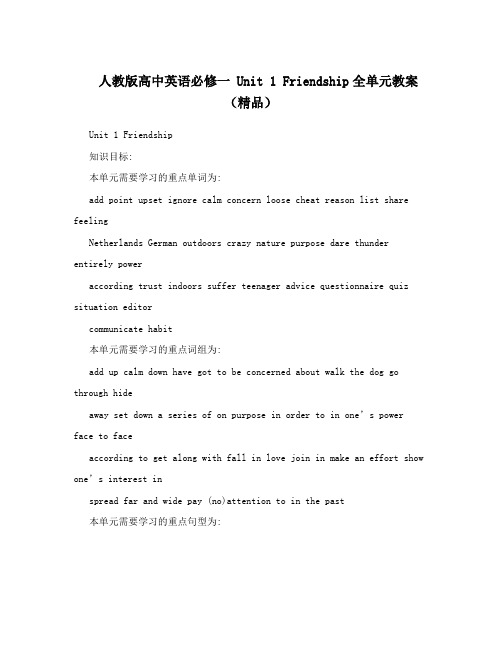
人教版高中英语必修一 Unit 1 Friendship全单元教案(精品)Unit 1 Friendship知识目标:本单元需要学习的重点单词为:add point upset ignore calm concern loose cheat reason list share feelingNetherlands German outdoors crazy nature purpose dare thunder entirely poweraccording trust indoors suffer teenager advice questionnaire quiz situation editorcommunicate habit本单元需要学习的重点词组为:add up calm down have got to be concerned about walk the dog go through hideaway set down a series of on purpose in order to in one’s power face to faceaccording to get along with fall in love join in make an effort show one’s interest inspread far and wide pay (no)attention to in the past本单元需要学习的重点句型为:1. You want to see a very interesting film with your friend, but your friend can’t go until he or she finishes cleaning the bicycle. (not. . . until. . . )2. When he or she borrowed it last time, he or she broke it and you had to pay to get itrepaired. (get sth. done)3. While walking the dog, you were careless and it got loose and was hit by a car. (while doing; get+adj. )4. Your friend, who doesn’t work hard, asks you to help him or her to cheat in the exam by looking at your paper, what will you do? (the Attributive Clause)5. I don’t want to set down a series of facts in a diary as most people do, but I want this diary itself to be my friend. (as. . . )6. I wonder if it’s because I haven’t been able to be outdoors for so long time that I’ve grownso crazy about everything to do with nature. (I wonder if/whether; it’s . . . that. . . )7. . . . I stayed awake on purpose until half past eleven one evening in order to have a goodlook at the moon for once by myself. (stay+adj. ; in order todo. . . )8. But as the moon gave far too much light, I didn’t dare open a window. (don’t dare(to)do. . . )9. . . . it was the first time in a year and a half that I’d seen the night face to face. . . (It is/was the first/second. . . time that+现在/过去完成时)10. Although I really try to talk to my classmates, I still find it hard to make good friendswith them. (find it+adj. /n. +to do. . . )本单元需要掌握的交际功能用语为:1. 态度(attitudes)Are you afraid that. . . ? I’ve grown so crazy about. . . I didn’t dare. . .2. 同意和不同意(agreement and disagreement)I agree. I think so. Exactly.I don’t agree. I don’t think so. I’m afraid not.3. 肯定程度(certainty)That’s correct. Of course not.本单元需要掌握的语法为:直接引语和间接引语(?):陈述句和疑问句1. 陈述句“I don’t want to set down a series of facts in a diary, ” said Anne.? Anne said that she didn’t want to set down a series of facts in a diary.2. 一般疑问句He asked, “Are you leaving tonight? ”? He asked us whether we were leaving that night.3. 特殊疑问句“When did you go to bed last night? ” father said to Anne.? Father asked Anne when she went to bed the night before.能力目标:1. 能运用所学语言讲述朋友间发生的事情以及朋友间的友谊和友情。
新课标人教版英语必修1:Unit1FriendshipPeriod1听说课教案

Unit 1 Friendship单元整体设计思路:第一课时听说课Warming up (p. 1); Listening (p. 41) and speaking第二课时阅读课Pre-reading (p. 2); Reading (p. 2); Comprehending (p. 3)第三课时语法课Discovering useful structures (p. 5); Using structures (p. 42-43)第四课时语言学习课Discovering useful words and expressions (p. 4); Using words and expressions (p. 41-42)第五课时综合语言练习课Reading and listeni ng (p. 6); Speaking (p.6); Listening task (p. 43) 第六课时写作课Reading and writing (p. 7); *Writing Task (p. 46, 选做)第七课时综合评价练习课Reading task (p. 44); Self-evaluation, Summing up and self-test/exercises第一课时听说课一、教学内容:Warming Up (p. 1); Listening (p. 41) and speaking二、教学目标:1.能力目标在本节课结束时,学生能够●就“朋友应具备什么品质”这一话题表达自己的看法,使用适当的形容词并通过简单举例来描述人的品质。
●在与其他人交流观点时使用同意或不同意的交际用语。
●理解听力材料中主人公对交友问题的看法,在教师的提示和帮助下简明扼要地归纳中心内容。
●在提供的语境中猜测新词汇的含义,并根据朋友应具有的品质这一话题,通过联想记忆扩展词汇量。
2.目标语言●重点词汇和短语upset, loose, ignore, add up, walk the dog,●重点句型结构calm … down, have got to, be concerned about, cheat in the exam3.文化目标领会友谊和朋友的真正内涵,懂得正确处理与朋友之间的问题。
人教版高中英语必修1教案Unit1Friendship
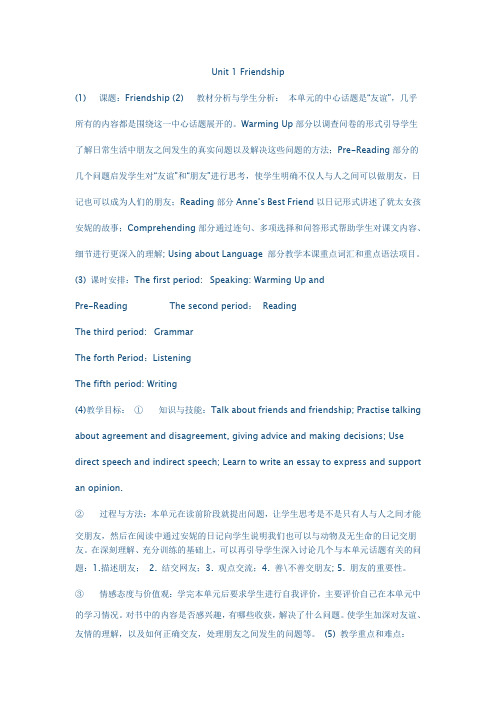
Unit 1 Friendship(1) 课题:Friendship (2) 教材分析与学生分析:本单元的中心话题是“友谊”,几乎所有的内容都是围绕这一中心话题展开的。
Warming Up部分以调查问卷的形式引导学生了解日常生活中朋友之间发生的真实问题以及解决这些问题的方法;Pre-Reading部分的几个问题启发学生对“友谊”和“朋友”进行思考,使学生明确不仅人与人之间可以做朋友,日记也可以成为人们的朋友;Reading部分Anne’s Best Friend以日记形式讲述了犹太女孩安妮的故事;Comprehending部分通过连句、多项选择和问答形式帮助学生对课文内容、细节进行更深入的理解; Using about Language 部分教学本课重点词汇和重点语法项目。
(3) 课时安排:The first period: Speaking: Warming Up andPre-Reading The second period: ReadingThe third period: GrammarThe forth Period:ListeningThe fifth period: Writing(4)教学目标:①知识与技能:Talk about friends and friendship; Practise talking about agreement and disagreement, giving advice and making decisions; Use direct speech and indirect speech; Learn to write an essay to express and support an opinion.②过程与方法:本单元在读前阶段就提出问题,让学生思考是不是只有人与人之间才能交朋友,然后在阅读中通过安妮的日记向学生说明我们也可以与动物及无生命的日记交朋友。
高一英语必修1_Unit_1《friendship》教案11
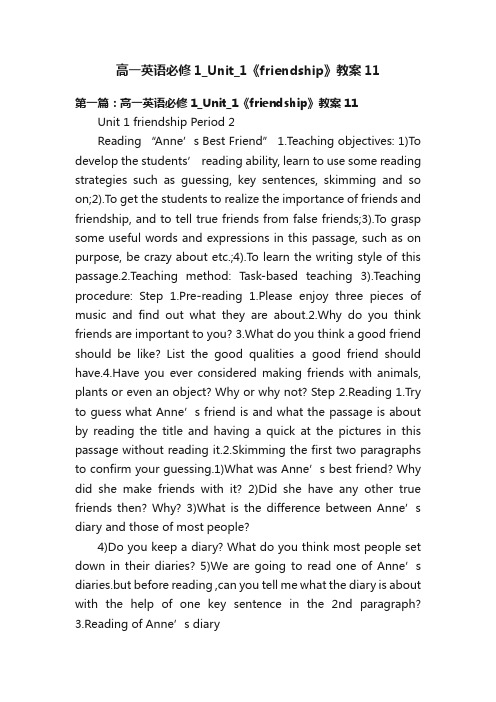
高一英语必修1_Unit_1《friendship》教案11第一篇:高一英语必修1_Unit_1《friendship》教案11 Unit 1 friendship Period 2Reading “Anne’s Best Friend” 1.Teaching objectives: 1)To develop the students’ reading ability, learn to use some reading strategies such as guessing, key sentences, skimming and so on;2).To get the students to realize the importance of friends and friendship, and to tell true friends from false friends;3).To grasp some useful words and expressions in this passage, such as on purpose, be crazy about etc.;4).T o learn the writing style of this passage.2.Teaching method: Task-based teaching 3).Teaching procedure: Step 1.Pre-reading 1.Please enjoy three pieces of music and find out what they are about.2.Why do you think friends are important to you? 3.What do you think a good friend should be like? List the good qualities a good friend should have.4.Have you ever considered making friends with animals, plants or even an object? Why or why not? Step 2.Reading 1.Try to guess what Anne’s friend is and what the passage is about by reading the title and having a quick at the pictures in this passage without reading it.2.Skimming the first two paragraphs to confirm your guessing.1)What was Anne’s best fr iend? Why did she make friends with it? 2)Did she have any other true friends then? Why? 3)What is the difference between Anne’s diary and those of most people?4)Do you keep a diary? What do you think most people set down in their diaries? 5)We are going to read one of Anne’s diaries.but before reading ,can you tell me what the diary is about with the help of one key sentence in the 2nd paragraph?3.Reading of Anne’s diaryHow she felt in the hiding place Two examples to show her feelings then Step 3.Post-reading 1.What would you miss most if you went into hiding like Anne and her family? Give your reasons.2.Group work Work in groups to decide what you would do if your family were going to be killed just because they did something the Emperor did not like.Where would you plan to hide?How would you arrange to get food given to you every day?What would you do to pass the time?------3.Discovering useful words and expressions Complete the following sentences, using words and expressions from Reading 1)She has grown _______ about computer games.2)Was it an accident or did David do it on _______? 3)From the beginning ,Paul made it clear that he would be ______(完全地)in control.4)He used to work _______ even in the middle of winter.5)Just the _______ of more food made her feel sick.6)You had better have a _________ talk with him.7)Born in a poor family, the manager _________ lots of hardships in his childhood.8)A diary is often kept to ________ what happens in people’s daily lives.Step 4.Talking about friends and friendship 1.There are many proverbs about friends and friendship.Choose the one you agree with and explain why, then choose one you disagree with and explain why.A friend in need is a friend indeed.Friends are like wine;the older, the better.A friend to all is a friend to none.The same man cannot be both friend and flatterer(阿谀奉承者).False friends are worse than open enemies.Walking with a friend in the dark is better than walking alone in the light.2.We have talked about friends and friendship today, can you write one or two sentences to express your understanding of friends and friendship.Step 5.Homework: 1.Interview a high school student,a businessman, a police officer and a housewife to find out their opinions about friends and friendship.Write a report to share it with the whole class.2.Describe one of your best friends following the writing style of this passage.Ending: Let’s sing this song about friends together第二篇:高一英语必修高一英语必修②Unit 1期末复习题一.单词拼写1.These small animals must store plenty of food if they are to s_________ the winter.2.There is a beautiful garden over there.Do you know whom it b__________ to.3.She took a ________ candle into the room, and the dark room lit up at once.4.This coat is of the latest s________.5.In my o_________, he is not the right person for the job.6.Do you have enough e_________ to prove that you are right?7.Don’t _________ not to know me, actually you know me very well.8.We couldn’t go for a walk because I have no time, b_________, it rains heavily.9.He s___________ all the street, but could not find his dear parents.10.As is known, the Great wall is one of the w___________ of the world.11.In the accident, only two people s__________ at last.12.The building is specially d__________ for the homeless people.13.T om has bought a new house, he needs to buy some f___________ before he moves into it.14.His father works on a ship, he is a s________.15.This is a r_______ coin, so it’s very valuable.二.翻译下列单词或短语1.作为对……的报答2.处理3.充当,担任4.与……处于战争状态5.寻找6.属于7.调查,朝……里面看 8.而不是,而非9.迷路,丢失 10.同意(某人的看法)11.高度评价 12.拆开13.毫无疑问问题的答案三.定语从句专练习: 用恰当的关系词填空。
高中英语必修一《Unit 1 Friendship》全英文说课稿
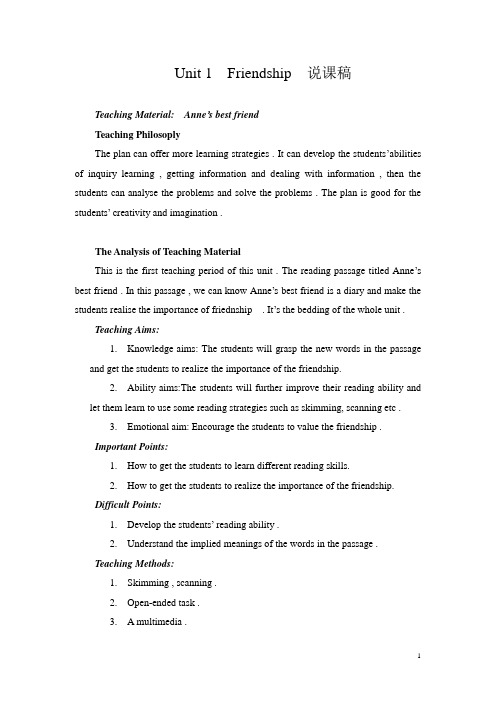
Unit 1 Friendship 说课稿Teaching Material: Anne’s best friendTeaching PhilosoplyThe plan can offer more learning strategies . It can develop the students’abilities of inquiry learning , getting information and dealing with information , then the students can analyse the problems and solve the problems . The plan is good for the students’ creativity and imagination .The Analysis of Teaching MaterialThis is the first teaching period of this unit . The reading passage titled Anne’s best friend . In this passage , we can know Anne’s best friend is a diary and make the students realise the importance of friednship . It’s the bedding of the whole unit .Teaching Aims:1.Knowledge aims: The students will grasp the new words in the passageand get the students to realize the importance of the friendship.2.Ability aims:The students will further improve their reading ability andlet them learn to use some reading strategies such as skimming, scanning etc .3.Emotional aim: Encourage the students to value the friendship .Important Points:1.How to get the students to learn different reading skills.2.How to get the students to realize the importance of the friendship.Difficult Points:1.Develop the students’ reading ability .2.Understand the implied meanings of the words in the passage .Teaching Methods:1.Skimming , scanning .2.Open-ended task .3. A multimedia .Teaching Procedures:Task 1: Warming UpFree talk to lead in the topic we will learn :Boys and girls , we are new for each other ,but I want to know : do you like to make frineds with me ? so your questions are :What qualities should a good friend have ? What do they often do ?Four students a group discuss with each other for 2 minutes.Task 2: Skimming1.Students read the title of the passage and observe the pictures and the outline of it to guess:Who is Anne’s best friend?Read the first paragraph ,tell me the answer .2.Read and find outHow many parts are there in the passage ?What are they ?One part is the background of Anne and Anne’s diary,the other part is about one page of Anne’s diary .Task 3: Careful Reading1.Read the passage quickly and fill in the form below .After finishing the form, the teacher should introduce more background about this passage to the students :This is a true story. It took place in Amsterdam, Holland in the early 1940s after the German Nazis had occupied most of Europe. The Nazi Party ruled Germany from 1933 to 1945. One of their key policies was to kill all the Jews in Europe. If any persons known to be Jews were found, they would be sent to concentration camps farther east, mostly in Poland. Families were separated and transported in trains For many days, they went without food, water, sanitation or fresh air. To avoid this terrible fate, some Jewish families went into hiding, often with the help of non-Jewish friends. This diary was written during the time when Anne and her family moved to escape from being killed by Nazis.2.Reading and guessingRead the dairy again and pay special attention to the boldfaced words. Then discuss in groups the inside meanings of them. Then think of some other words or expressions to describe Anne’s feelings and thoughts.1.2.Students work in group of four to discuss the following open questions:• 1.Why did the windows stay closed?• 2.Guess the meanings of “spellbound”, “ hold me entirely in their power” from the discourse(语篇,上下文).• 3.Which sentences attract you in the passage?Task 4. DiscussDo you think the friendship is very important to you ? Why or why not ?Task 5:ActivityFour students a group to discuss the situation:Suppose you four have to hide yourselves for 3 months. During the three months, you will be offered the basic food, water and clothes. Your group can take 5 things with you.What will you take? Why?How will you spend the 3 months?How will you treat each other and make friends ?How will you understand ‘A friend in need is a friend indeed’ at that time ?•Assignment• 1.Surf the internet to find Anne’s Diary and read some of it. Print out a piece of the diary and write down your feelings after reading it on the page. We will share the pieces and your feelings with the whole class.2.. Do Ex1,2 on Page3.[Teaching reflection]This teaching material is difficult for the students to understand ,because they don’t have enough background information about this diary . I guess the teacher should give the students enough background introduction ,if not , the aims of this class are hard to be reached .。
新人教版高中英语必修1Unit1 Friendship教案
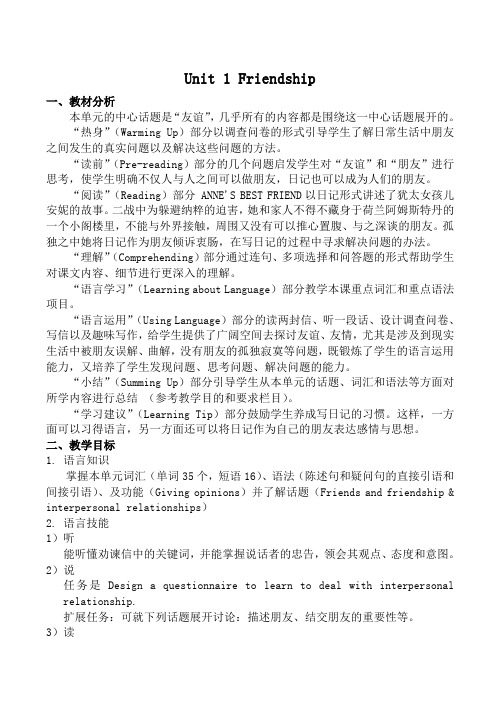
Unit 1 Friendship一、教材分析本单元的中心话题是“友谊”,几乎所有的内容都是围绕这一中心话题展开的。
“热身”(Warming Up)部分以调查问卷的形式引导学生了解日常生活中朋友之间发生的真实问题以及解决这些问题的方法。
“读前”(Pre-reading)部分的几个问题启发学生对“友谊”和“朋友”进行思考,使学生明确不仅人与人之间可以做朋友,日记也可以成为人们的朋友。
“阅读”(Reading)部分 ANNE'S BEST FRIEND以日记形式讲述了犹太女孩儿安妮的故事。
二战中为躲避纳粹的迫害,她和家人不得不藏身于荷兰阿姆斯特丹的一个小阁楼里,不能与外界接触,周围又没有可以推心置腹、与之深谈的朋友。
孤独之中她将日记作为朋友倾诉衷肠,在写日记的过程中寻求解决问题的办法。
“理解”(Comprehending)部分通过连句、多项选择和问答题的形式帮助学生对课文内容、细节进行更深入的理解。
“语言学习”(Learning about Language)部分教学本课重点词汇和重点语法项目。
“语言运用”(Using Language)部分的读两封信、听一段话、设计调查问卷、写信以及趣味写作,给学生提供了广阔空间去探讨友谊、友情,尤其是涉及到现实生活中被朋友误解、曲解,没有朋友的孤独寂寞等问题,既锻炼了学生的语言运用能力,又培养了学生发现问题、思考问题、解决问题的能力。
“小结”(Summing Up)部分引导学生从本单元的话题、词汇和语法等方面对所学内容进行总结(参考教学目的和要求栏目)。
“学习建议”(Learning Tip)部分鼓励学生养成写日记的习惯。
这样,一方面可以习得语言,另一方面还可以将日记作为自己的朋友表达感情与思想。
二、教学目标1. 语言知识掌握本单元词汇(单词35个,短语16)、语法(陈述句和疑问句的直接引语和间接引语)、及功能(Giving opinions)并了解话题(Friends and friendship & interpersonal relationships)2. 语言技能1)听能听懂劝谏信中的关键词,并能掌握说话者的忠告,领会其观点、态度和意图。
(word完整版)人教版高中英语必修一Unit1教案.doc
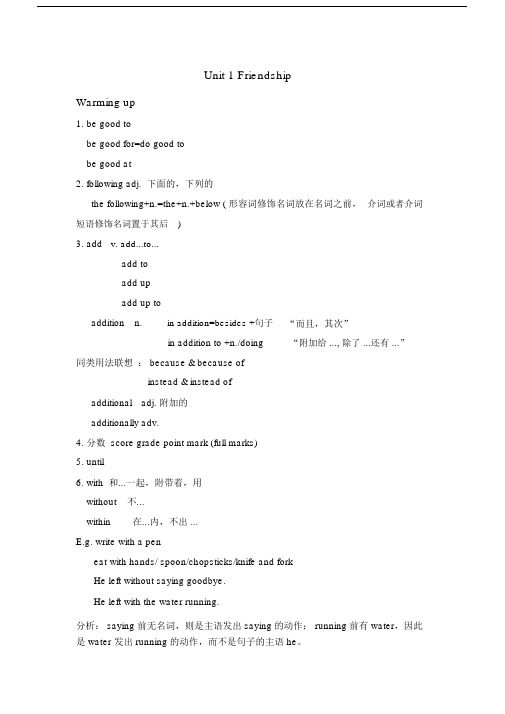
Unit 1 FriendshipWarming up1.be good tobe good for=do good tobe good at2.following adj. 下面的,下列的the following+n.=the+n.+below ( 形容词修饰名词放在名词之前,介词或者介词短语修饰名词置于其后)3. add v. add...to...add toadd upadd up toaddition n.in addition=besides +句子in addition to +n./doing 同类用法联想: because & because ofinstead & instead of “而且,其次”“附加给 ..., 除了 ...还有 ...”additional adj. 附加的additionally adv.4. 分数 score grade point mark (full marks)5. until6. with 和...一起,附带着,用without 不...within在...内,不出 ...E.g. write with a peneat with hands/ spoon/chopsticks/knife and forkHe left without saying goodbye.He left with the water running.分析: saying 前无名词,则是主语发出 saying 的动作; running 前有 water,因此是 water 发出 running 的动作,而不是句子的主语 he。
翻译练习:(1)他今天去上班没带领带。
Today, he went to work without (wearing) his tie.(2)他在没有其他人帮助的情况下自己完成了作业。
7.pay for payto do sth8. get sb to do sth(make/have/let sb do sth)get sb/sth doneget done get lost/prepared/dressed/involved9.形容词做状语,表示句子主语的特征、属性和状态副词做状语,表示谓语动词的完成方式E.g. He returned home last night, sad and disappointed.He left hurriedly.10. concern n. 担心,忧虑concern about/for/over...E.g. She hasn’ t been seen for four days and there is concern for her safety.That is a big concern.v. 涉及,与 ...有关be concerned withconcerning E.g. He asked several questions concerning the future of the company.翻译练习:不要问女人们涉及她们年龄的问题。
Unit1Friendship英语教案
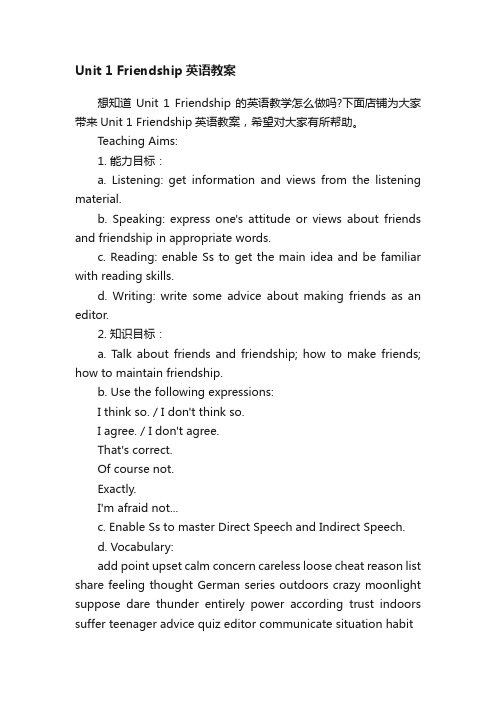
Unit 1 Friendship英语教案想知道Unit 1 Friendship的英语教学怎么做吗?下面店铺为大家带来Unit 1 Friendship英语教案,希望对大家有所帮助。
Teaching Aims:1. 能力目标:a. Listening: get information and views from the listening material.b. Speaking: express one's attitude or views about friends and friendship in appropriate words.c. Reading: enable Ss to get the main idea and be familiar with reading skills.d. Writing: write some advice about making friends as an editor.2. 知识目标:a. Talk about friends and friendship; how to make friends; how to maintain friendship.b. Use the following expressions:I think so. / I don't think so.I agree. / I don't agree.That's correct.Of course not.Exactly.I'm afraid not...c. Enable Ss to master Direct Speech and Indirect Speech.d. Vocabulary:add point upset calm concern careless loose cheat reason list share feeling thought German series outdoors crazy moonlight suppose dare thunder entirely power according trust indoors suffer teenager advice quiz editor communicate situation habitadd up calm down have got to be concerned about walk the dog go through hide away set down a series of on purpose in order to face to face according to get along with fall in love join in3. 情感目标:a. Arose Ss' interest in learning Englishb. Encourage Ss to be active in the activities and make Ss be confidentc. Develop the ability to cooperate with others.4. 策略目标:a. Develop Ss' cognitive strategy: taking notes while listening.b. Develop Ss' communicative strategy.5. 文化目标:a. Enable Ss to get to know different opinions about making friends from different countries.Teaching design:Period 1 Warming-up 1课时I. Teaching objectives:1. Have Ss learn how to describe their friends and friendship with new phrases and structures.2. Have Ss learn to solve problems that may occur between friends.3. Cultivate Ss to form the good habit of learning English in Senior Middle School.II. Teaching important points:1. Use the given adjs. and sentences structures to describe one of your friends.2. Learn to evaluate friends and friendship.III. Teaching difficult points:1. Work together with partners and describe one of yourgood friends.2. Discuss with partners and find out ways to solve the problems.IV. Teaching procedures:Step 1. Lead-in and warming-upBefore the lesson, T can arose Ss' interests by introducing oneself and get Ss to talk about their summer holidays, or whether they had made friends during holidays.Free Talk: 3 mins1. How did you spend your summer holidays? How did you feel? What did you do?2. What do you think of your new school? Do you like it? Could you say anything about it?3. Do you like making friends? How do you get in touch with your friends? Do you have many friends? Where are they now? Do you have any old friends in our school?Step II. Think it over1. Give a brief description of one of T's friends. The following phrases and structures may be useful: (3mins)His / Her name is...He / She is...years old.He / She likes .... and ...dislikes...He / She is very kind / friendly / humorous...When / Where we got to know each other...Step III. Make a survey1. List some qualities of a good friend or your ideal friend, have Ss get into groups of 4 to 5 to find out what each one has listed?2. Add up the scores Ss got and show the explanations of every type.3. Have Ss tell their partners the standards of good friends with the following structures:I think a good friend should (not) be...In my opinion. From my point of view. So far as I'm concerned.I suppose. A good friend is someone who...Step IV. Talking and sharing (working in pairs)1. If your best friend does anything wrong, what will you do?2. Proverbs: "What is a friend?"A British newspaper once offered a prize for the best definition of a friend. If Ss were the editors, they could choose the best one from the following entires, and explain why."A friend in need is a friend indeed.""Friends are like wine, the older, the better.""A friend is a second self.""A friend to all is a friend to none."Step V. Homework1. Write a short passage about your best friend.2. Review the language points.3. Preview the new words and expressions.Period 2 Reading 2课时I. Teaching objectives:1. Develop Ss ' reading ability, learn to use some reading strategies, such as skimming, scanning, and so on.2. Get Ss to realize the importance of friends and friendship and learn how to tell true friends from the false.3. Grasp some useful words and expressions in this passage.4. Learn the writing style of this passage.II. Teaching method:Task-based teachingIII. Teaching procedures:StepI.Pre-reading1. Have Ss discuss the following questions in group-work:Who is your best friend? Does a friend always have to be a person? What else can be your friend?Step II. Reading1. Have Ss try to guess what Anne's friend is and what the passage is about by reading the title and having a quick look at the pictures in this passage without reading it through.2. Skimming the 1st two paras to confirm the former guess.a. What was Anne's best friend? Why did she make friend with it?b. Did she have any true friends then? Why?c. What is the difference between Anne's diary and those of most people?d. Do you keep a diary? What do you think most people set down in their diaries?3. Reading of Anne's diaryHow did she feel in the hiding place?Two examples to show her feelings then.Step III. Post-reading1. What would you miss most if you went into a hiding place like Anne and her family? Reasons support.2. Group-workWork in groups to decide what you should do if your family were going to be killed just because they did something the Emperors did not like."Where would you plan to hide?""How would you arrange to get food given to you every day?""What would our do to pass the time?"Step IV. Talking about friends and friendshipHave Ss talk about friends and friendship, and write one or two sentences to express one's own understanding of friends and friendship in group-work.Step V. Homework1. Interview a student or a parent to find out their opinions about friends and friendship. Write a short report to share it with the whole class.2. Describe one of your best friends, following the writing style of this passage.Period 3 Grammar 1课时I. Teaching objectives:Learn to use Direct & Indirect SpeechII. Teaching important points:Summarize the grammatical rulesIII. Teaching difficult points:The special casesIV. Teaching procedures:StepI.Lead-inLast class, we learnt Anne Frank's story. She is telling her story to two of her friends--you and Tom. Tom has something wrong with his ears, so you have to repeat Anne's sentences, using Indirect Speech. Sometimes you explain Tom's sentences to Anne---1. "Do you feel sad when you are not able to go outdoors?" Tom asked Anne---Tom asked Anne if / whether she felt sad when she was not able to go outdoors.......Step II. Grammar focus1. Have Ss summarize the rules when they changed Direct Speech into Indirect Speech, what should be changed?2. Group-work for discussion.3. Check out: sentence structure, tense, pron, adverbial of time or place, verb.4. Rules focus:a. 陈述句:She said,"I am very happy to help you."---She said she was very happy to help you.b. 一般疑问句/ 选择疑问句:He asked me, "Do you like playing football?"---He asked me if / whether I like playing football.She asked me whether he could do it or not.c. 特殊疑问句:My sister asked me,"How do you like the film?"---My sister asked me How I liked the film.d. 祈使句:The captain ordered, "Be quiet!"---The captain ordered us to be quiet.e. 注意:l 间接引语语序: 陈述语序.l 客观事实,真理;时态不变.l 指示代词,时间,地点状语做相应变化.f. SummaryDirect Speech一般现在时do一般将来时will do现在进行时is doing一般过去时did现在完成时have done过去完成时had doneIndirect Speech一般过去时did过去将来时would do过去进行时was doing过去完成时had done过去完成时had done过去完成时had doneStep V. Homeworkl Exs 1 on p42l Look up new words and expressions from dictionary and do the prevision.Period 4 Words & Expressions 1课时I. Teaching objectives:Learn new words and expressionsII. Teaching important points:1. Pay attention to the different forms of the words2. Master the words and expressions through the Exs.III. Teaching difficult points:1. Emphasize the methods which can be useful and efficient to do the memory.2. How to use the new words and expressions into Ss' own composition-writing.IV. Teaching method:Self-summary;Discussion;PracticeV. Teaching procedures:StepI.Warming-up1. Check out the new words and expressions looked up from dictionary2. Have Ss share their works, including the Chinese meaning, the form, the phrases, the examples, and the usage.Step II. Practice1. Do the words Exs in this unit2. Discuss the answers in group-work3. Check out the answersStep III. Summary1. Emphasize the key points of the words in this unit, esp some phrases and structures.Step IV. Homeworkl Recite the words and expressions.l Preview the listening and speaking part.Period 5 Listening & Speaking 1课时I. Teaching objectives:1. Practice Ss’ listening ability.2. Pra ctice Ss’ speaking skills of how to offer advice.3. Improve Ss’ ability to help others to solve problems.II. Teaching proceduresStep 1. Reading1. Have Ss think about the questions on books, and then try to guess the brief content of the listening material according to the questions given in group-work.Step 2. Listening1. Have Ss get to know that besides you, Lisa also asks Miss Wang for help. What advice does she give her? Now, let Ss listento what she says.2. 1st-time listening: have Ss listen to the tape from the beginning to the end without any pause, ask Ss to take some notes while listening, and discuss the main idea of the listening material in group-work.3. 2nd-time listening: have Ss listen to the tape again, and encourage Ss to repeat every sentence as best as they can after the pause. So Ss should pay attention to notes-taking, esp. the WH-Qs.4. 3rd-time listening: the last time, have Ss listen to the tape and check out their answers according to what they heard before.5. Check out the Exs.Step 3. Post-listening & Speaking1. Have Ss think about the Q:“Do you think Miss Wang’s advice is helpful?”2. Have Ss discuss the former Q in group-work, and have a free talk within 1min.3. Now suppose Ss are editors of Radio for Teenagers, here are some problems for Ss to offer advice. (Give each group a problem and ask them to write their advice down.)4. Have Ss come to the front and share their opinions with the whole class.Step 4. Discussion1. Ask Ss, “Do you think Anne should obey her father’s advice?”2. Have Ss discuss the Q in group-work, and express their reasons to support their ideas.Step 5. Homework1. Have Ss review the listening material and consult the dictionary to deal with the words and phrases they encountered.2. Preview the writing part.Period 6 Listening & Speaking 2课时I. Teaching objectives:1. Practice Ss’ writing ability.2. Improve Ss’ ability to write advice.II. Teaching proceduresStepI.Lead-in1. Have Ss read Xiao Dong’s letter on p7, and then discuss the Q in group-work within 2mins:“What is Xiao Dong’s problem?”2. Have every group make a list to set its own advice down for Xiao Dong.Step II. Writing the draft1. Have Ss get known that they should make the outline or the draft before writing.2. Have Ss discuss how to write the outline in group-work within 1 min.3. Have Ss pay attention to how to write a letter of advice. Here are some tips:First, why not……?If you do this, ……Secondly, you should / can……Then / That way……Thirdly, it would be a good idea o f……By doing this, ……Step III. Writing and Editing1. Have Ss compose their writing within 30 mins.2. Have Ss change their editing one another, and make the comments for others.3. Choose the best one to share with the whole class.Step IV. Homework1. Have Ss summarize this unit and review new words, expressions, sentence structures, language points, grammar rules and examples.2. Finish the Exs of this unit on workbook.Period 7 Summary 1课时I. Teaching objectives:1. Develop Ss’ ability of how to ma ke a summary.2. Review unit 1.II. Teaching proceduresStepI.Summing-up1. Have Ss discuss how to make a summary and what kinds of items they could sum up in group-work within 3mins.2. Have Ss make a list, which includes the new words, expressions, sentence structures, language points, grammar rules, examples, and so on.3. Check out the summary.Step II. Exs practice1. Have Ss finish the Exs of this unit.2. Check out the answers within group-work.Step III. Fill in the blanks1. Have Ss fill in the blanks on p8; p47 to make the conclusion of the whole unit.2. Change their summary one another and have Ss comment on others’ work.Step IV. Homework1. Prepare for the quiz for this unit.。
人教版高中英语 必修一Unit 1 Friendship写作课教案

人教版高中英语必修一Unit 1 Friendship写作课教案How to write a letter for advice一、Teaching objectives:1. To be able to give others some advice in English.2. To be able to write a letter of advice with the help of the sentence patterns.二、Learning important &difficult points1. To master the structure of an English letter.2. To use some proper transition words in writing.三、Teaching methods:1. Task-based method2. Communicative method四、Learning methods:1. Explorative method2. Group work3. Individual work五、Teaching aids:1. Multi-media2. Blackboard.3. chalks六、Teaching procedures:Ⅰ. Explorative study to read a letter from Kate1. Read the letter and answer the following questions.(1)What is Peter’s problem?(2)What advice does Kate give Peter?(3)How many parts can you divide the letter into? What’s each part about?2. Offer a writing pattern to SsSs read the writing pattern on the guiding paper and keep it in mind.Ⅱ. Writing materials for referenceIn this part, Ss will learn some more sentence patterns and choose the ones they prefer.1. Sentence patterns for Part1.(1)You have asked me for my advice on (doing)sth. ... and I will try to make some suggestions.(2)I’m sorry to hear that ... I’d like to offer you some advice.2. Sentence patterns for Part 2(1) I would like to suggest that (clause)...(2)In my opinion, you can do sth.(3)You’d better do sth.(4)Why not do sth. ?(5) It would be a good idea to do sth.transition words:(1)First, ... Second, ... Third,… At last,…(2)Firstly,… secondly, … thirdly,… finally,…3. Sentence patterns for Part 3:(1)These are only my suggestions. I hope you will find them useful.(2)I’m looking forward to your reply. / Looking forward to hearing from you.Ⅲ、Writing practice.1. Ss first discuss how to express the key words.2. Work in groups to put the key words into Chinese.3. Write a letter individually.4. T gives comments.假如你是李华,你的朋友Mary写信向你诉苦,在新的学校没有好朋友,心情低落。
新课标高一英语必修一全册教案
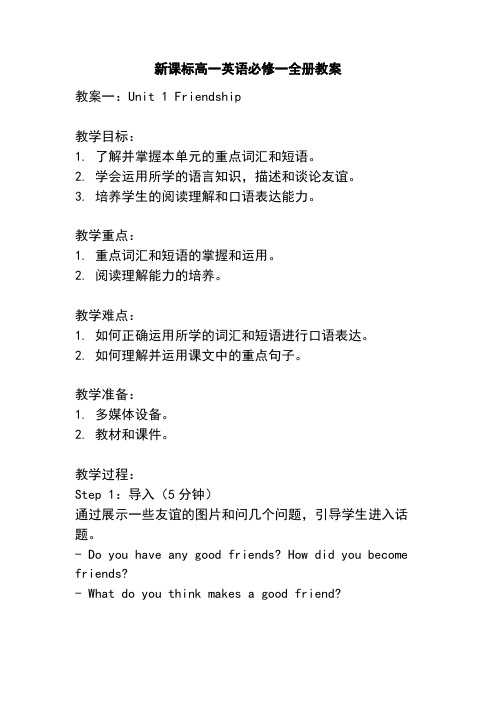
新课标高一英语必修一全册教案教案一:Unit 1 Friendship教学目标:1. 了解并掌握本单元的重点词汇和短语。
2. 学会运用所学的语言知识,描述和谈论友谊。
3. 培养学生的阅读理解和口语表达能力。
教学重点:1. 重点词汇和短语的掌握和运用。
2. 阅读理解能力的培养。
教学难点:1. 如何正确运用所学的词汇和短语进行口语表达。
2. 如何理解并运用课文中的重点句子。
教学准备:1. 多媒体设备。
2. 教材和课件。
教学过程:Step 1:导入(5分钟)通过展示一些友谊的图片和问几个问题,引导学生进入话题。
- Do you have any good friends? How did you become friends?- What do you think makes a good friend?Step 2:词汇和短语学习(10分钟)通过多媒体展示和示范,教授本单元的重点词汇和短语。
- friendship, loyal, trust, support, companion, betray, argue, forgive, appreciate, value, make friends, keep in touch, get along with, fall out with, make upStep 3:阅读理解(20分钟)教师通过多媒体展示,让学生阅读课文,并进行理解。
- 学生阅读课文,并回答一些问题,如:What is the main idea of the passage? What does the author think about friendship? How does the author describe a good friend?Step 4:语言运用(15分钟)通过讨论和练习,让学生运用所学的语言知识进行口语表达。
- 讨论题目:What qualities do you think a good friend should have? Give examples to support your ideas.- 练习:学生分组进行角色扮演,模拟对话中的情景。
高一英语必修一《Unit1Friendship》教案
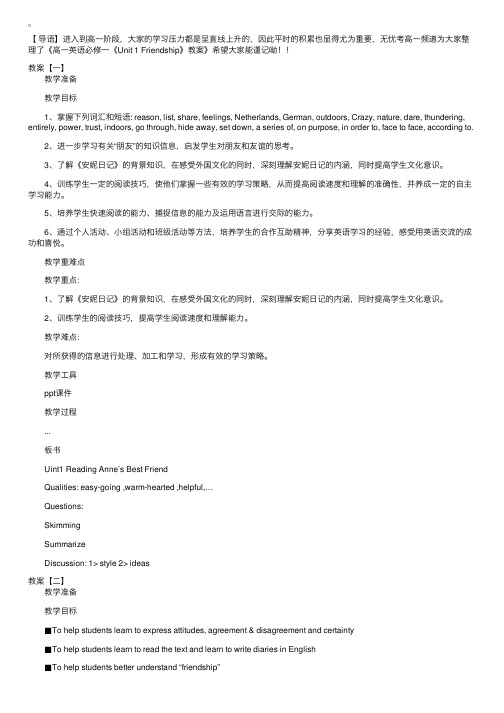
【导语】进⼊到⾼⼀阶段,⼤家的学习压⼒都是呈直线上升的,因此平时的积累也显得尤为重要,⽆忧考⾼⼀频道为⼤家整理了《⾼⼀英语必修⼀《Unit 1 Friendship》教案》希望⼤家能谨记呦!!教案【⼀】 教学准备 教学⽬标 1、掌握下列词汇和短语: reason, list, share, feelings, Netherlands, German, outdoors, Crazy, nature, dare, thundering, entirely, power, trust, indoors, go through, hide away, set down, a series of, on purpose, in order to, face to face, according to. 2、进⼀步学习有关“朋友”的知识信息,启发学⽣对朋友和友谊的思考。
3、了解《安妮⽇记》的背景知识,在感受外国⽂化的同时,深刻理解安妮⽇记的内涵,同时提⾼学⽣⽂化意识。
4、训练学⽣⼀定的阅读技巧,使他们掌握⼀些有效的学习策略,从⽽提⾼阅读速度和理解的准确性,并养成⼀定的⾃主学习能⼒。
5、培养学⽣快速阅读的能⼒、捕捉信息的能⼒及运⽤语⾔进⾏交际的能⼒。
6、通过个⼈活动、⼩组活动和班级活动等⽅法,培养学⽣的合作互助精神,分享英语学习的经验,感受⽤英语交流的成功和喜悦。
教学重难点 教学重点: 1、了解《安妮⽇记》的背景知识,在感受外国⽂化的同时,深刻理解安妮⽇记的内涵,同时提⾼学⽣⽂化意识。
2、训练学⽣的阅读技巧,提⾼学⽣阅读速度和理解能⼒。
教学难点: 对所获得的信息进⾏处理、加⼯和学习,形成有效的学习策略。
教学⼯具 ppt课件 教学过程 ... 板书 Uint1 Reading Anne’s Best Friend Qualities: easy-going ,warm-hearted ,helpful,… Questions: Skimming Summarize Discussion: 1> style 2> ideas教案【⼆】 教学准备 教学⽬标 ■To help students learn to express attitudes, agreement & disagreement and certainty ■To help students learn to read the text and learn to write diaries in English ■To help students better understand “friendship” ■To help students learn to understand and use some important words and expressions ■To help students identify examples of Direct Speech & Indirect Speech (I): statements and questions in the text 教学重难点 Words upset, ignore, calm, concern, settle, suffer, recover, pack Expressions add up, calm down, have got to, be concerned about, go through, set down, a series of, on purpose, in order to, at dusk, face to facer, no longer/ not …any longer, suffer from, get/ be tired of, pack (sth.) up, get along with, fall in love, join in Patterns “I don’t want to set down a series of facts in a diary as most people do,” said Anne. →Anne said that she didn’t want to set down a series of facts in a diary as most people do. I stayed awake on purpose until half past eleven… …it was the first time in a year and a half that I’d seen the night face to face… 教学⼯具 ppt 教学过程 Hello, everyone. I’m so glad to be your teacher of English. I’d like to make friends with you, to build up a close friendship with you. Today we shall take Unit 1. The topic of this unit is Friendship. What do you think friendship is? 1. Warming up ⑴ Warming up by defining friendship Hello, everyone. I’m so glad to be your teacher of English. I’d like to make friends with you, to build up a close friendship with you. Today we shall take Unit 1. The topic of this unit is Friendship. What do you think friendship is? Yeah, there are many explanations about friendship. However, friendship is a relationship that can’t be restricted(限制)by definition(定义). It can only be experienced. True friendship can exist between any two souls, be it between people or animals. It can happen at any moment, to anyone. Even to lifeless things, like a diary, a ball, a friendship can happen. Then what is your opinion about friendship? Do you think that friendship is important to our life? Why? ⑵Warming up by learning to solve problems Nice to meet you, class. We shall be friends from now on. For everybody needs friends. But being a good friend can sometimes be hard work. Learning how to solve problems in a friendship can make you a better friend and a happier person. Discuss the situation below and try to solve the problems wisely. Common problems among teenagers Solution Some of the common problems include forgetting friends’ birthday, not keeping promises, letting out friends’ secrets and so on. Maybe we can have a heart-to-heart talk with our friends to ask for forgiveness. Situation 1: Friends get angry with each other when they try to talk about something difficult. Try to understand your friend/ Try to talk about the problem in a different way. Situation 2: Friends don’t know how to apologize Start by telling each other that you are sorry. A simple apology is often enough and is a good starting point. Situation 3: Some friends don’t know how to keep secrets. Keep your secrets to yourself Tips on being a good friend Treat your friends the way you want to be treated. Keep secrets that are told to you. Pay attention when your friend is talking. Keep your promises. Share things with your friend. Tell your friend the truth. Stick up for your friend. ⑶Warming up by doing a survey Good morning, class. I am your teacher of English. Glad to be here with you. Today we shall take Unit 1 Friendship. To be frankly, I’d like very much to keep a close friendship with you, my dear students, in the following years. How about you then? Ok, thanks. I do hope to be your good teacher as well as your helpful friend (良师益友). Now please do the survey on page one. Add up your score according to the scoring sheet on page 8. You don’t have to tell your results. You can just keep it a secret.。
高中英语 Unit 1《friendship》教案15 新人教版必修1

新课标英语高一上Module 1 Unit 1 Friendship单元教学目标及Period 6教案Teaching Objectives:Knowledge Objectives:1. Enable students to talk about friends and friendship, and learnto use some adjectives to describe the qualities a good friend should have.2. Learn some useful words and expressions, e.g., upset, ignore, crazy, etc.3. Learn how to talk about agreement and disagreement, e.g., I think so. /I don’t think so; You are quite right. / I don’t think you are right, etc.4. Learn and pratice the direct speech and the indirect speech.5. Help the students to learn how to write a reply letter to give advice on communicating with people.Ability objectives:To develop the students’ speaking, reading, listening, and writing abilities.Moral & Emotion:1. To develop the students’ cooperative abilities.2. To realize the importance of friendship and know how to get onwell with others.Culture Objectives:To know the different culture about friendship between China and foreign countries.Period 1: Speaking ( Warming Up & Speaking )Period 2: Reading ( Pre-reading, Reading & Comprehending )Period 3: Language Structure( Expression of important words and structures in the passage. ) Period 4: Listening & Speaking( Using language ---- Reading, listening and writing & Workbook—Speaking Task. )Period 5: Grammar ( Discovering useful structures )Period 6: Writing ( Using Language --- Reading and writing )Period 7: Revision ( Words dictation &Summing up & Learning tip &Exercises )Teaching Plan for the Six PeriodTeaching Contents: Speaking & WritingTeaching Objectives:Knowledge Objectives:1. Help the students to learn how to write a letter to give adviceon communicating with others.2. To learn to write a reply letter in English.Ability Objectives:To develop the students’ writing skills.Learning Strategies:To develop the abilities of organizing information, expressing themselves & communicating in English freely.Moral & Emotion:1. To realize the importance of group cooperation.2. To know the ways of making friends.Key Points:1. To learn to give advice.2. To organize the advice into completed sentences and thenwrite a reply letter.3. To make clear the form of letter writing.Teaching methods:1. Task-based learning2. DiscussionTeaching Aids: a posterTeaching Procedures:Stage I. What’s Xiao Dong’s problem?Step1. Show a letter to the students and ask the Ss to help you to reply the letter in English.Step 2. Share the letter together, then make clear where the writer is from and who he is, and what problems he is facing now.Stage II. What should Xiao Dong do?Step 1. Ask individuals to talk about what they would do if they face the same problem.Step 2. Work in groups of six to give advice to Xiao Dong as much as possible. Step 3. Each group choose one member to speak out their advice. One point for one piece of advice. The teacher list them on the Bb when the students report.Stage III. How to write a reply letter in English?Step 1. Ask Ss whether they are clear about the form of letter writing. Step 2. Revise the form of letter writing.Step 3. Guide the students to write the beginning and the ending of this reply letter.Step 4. Work in groups of 6 to complete the letter, pay attention to the combination of each sentence. Guide the students to use someconjunctive words, eg. Firstly, secondly, thirdly, etc. to organizetheir advice to Xiao Dong.Step 5. Choose two or three groups to report their letters.Stage IV. The letter on the Textbook.Step 1. Turn to Page7 and read the letter loudly together.Step 2. Explain some language points if necessary.Stage V. Homework.Ask Ss to write the reply letter individually on the homework books.( P.S.: The letter that the teacher presents at the beginning of the class is not the one on the textbook but similar to it. )The letter that the teacher shows on the blackboard:Dear Miss Li,I’m a student from Jiaji Middle School. I have a p roblem. I’m not very good at communicating with people. Although I really try to talk to my classmates,I still find it hard to make good friends with them. So I feel quite lonelysometimes. I do want to change this situation, but I don’t know how. I would be grateful if you give me some advice.。
2024年高一英语必修一unit1friendship全单元课件
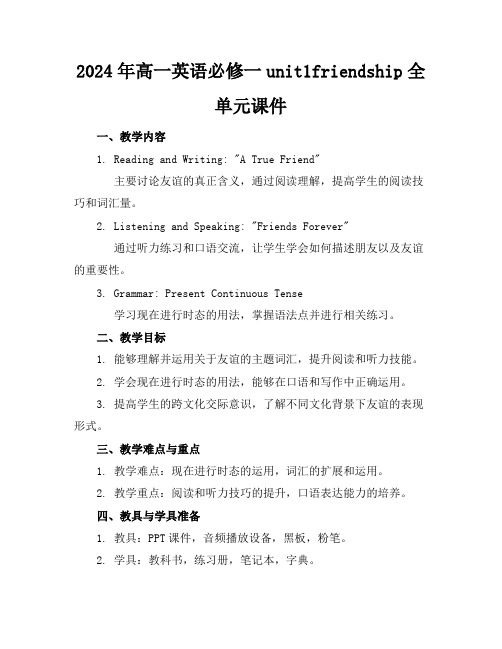
2024年高一英语必修一unit1friendship全单元课件一、教学内容1. Reading and Writing: "A True Friend"主要讨论友谊的真正含义,通过阅读理解,提高学生的阅读技巧和词汇量。
2. Listening and Speaking: "Friends Forever"通过听力练习和口语交流,让学生学会如何描述朋友以及友谊的重要性。
3. Grammar: Present Continuous Tense学习现在进行时态的用法,掌握语法点并进行相关练习。
二、教学目标1. 能够理解并运用关于友谊的主题词汇,提升阅读和听力技能。
2. 学会现在进行时态的用法,能够在口语和写作中正确运用。
3. 提高学生的跨文化交际意识,了解不同文化背景下友谊的表现形式。
三、教学难点与重点1. 教学难点:现在进行时态的运用,词汇的扩展和运用。
2. 教学重点:阅读和听力技巧的提升,口语表达能力的培养。
四、教具与学具准备1. 教具:PPT课件,音频播放设备,黑板,粉笔。
2. 学具:教科书,练习册,笔记本,字典。
五、教学过程1. 导入:通过展示不同国家的友谊图片,引发学生对友谊主题的兴趣。
2. 阅读理解:让学生阅读课文"A True Friend",讲解生词和短语,回答相关问题。
3. 例题讲解:针对现在进行时态,给出例句,解释语法点,进行互动问答。
4. 随堂练习:进行听力和口语练习,巩固现在进行时态的应用。
5. 小组讨论:让学生分组讨论关于友谊的话题,练习口语表达。
六、板书设计1. 板书Friendship2. 板书内容:课文主题:A True Friend,Friends Forever重点词汇:loyalty,trust,support,care,understanding语法点:现在进行时态的构成和用法七、作业设计1. 作业题目:根据听力材料,回答相关问题。
- 1、下载文档前请自行甄别文档内容的完整性,平台不提供额外的编辑、内容补充、找答案等附加服务。
- 2、"仅部分预览"的文档,不可在线预览部分如存在完整性等问题,可反馈申请退款(可完整预览的文档不适用该条件!)。
- 3、如文档侵犯您的权益,请联系客服反馈,我们会尽快为您处理(人工客服工作时间:9:00-18:30)。
good morning, class. i am your teacher of english. glad to be here with you. today weshall take unit 1 friendship.
to be frankly, i’d like very much to keep a close friendship with you, my dear students, inthe following years. how about you then? ok, thanks. i do hope to be your good teacher aswell as your helpful friend (良师益友).
…it was the first time in a year and a half that i’d seen the night face to face…教学工具
ppt
教学过程
hello, everyone. i’m so glad to be your teacher of english. i’d like to make friends withyou, to build up a close friendship with you. today we shall take unit 1. the topic of this unit isfriendship. what do you think friendship is?
2、进一步学习有关“朋友”的知识信息,启发学生对朋友和友谊的思考。
3、了解《安妮日记》的背景知识,在感受外国文化的同时,深刻理解安妮日记的内涵,同时提高学生文化意识。
4、训练学生一定的阅读技巧,使他们掌握一些有效的学习策略,从而提高阅读速度和理解的准确性,并养成一定的自主学习能力。
5、培养学生快速阅读的能力、捕捉信息的能力及运用语言进行交际的能力。
■to help students learn to understand and use some important words and expressions■to help students identify examples of direct speech & indirect speech (i): statementsand questions in the text
yeah, there are many explanations about friendship. however, friendship is arelationship that can’t be restricted(限制)by definition(定义). it can only be experienced. truefriendship can exist between any two souls, be it between people or animals. it can happenat any moment, to anyone. even to lifeless things, like a diary, a ball, a friendship canhappen.
1. warming up
⑴warming up by defining friendship
hello, everyone. i’m so glad to be your teacher of english. i’d like to make friends withyou, to build up a close friendship with you. today we shall take unit 1. the topic of this unit isfriendship. what do you think friendship is?
patterns
“i don’t want to set down a series of facts in a diary as most people do,” said anne.→anne said that she didn’t want to set down a series of facts in a diary asmost people do.i stayed awake on purpose until half past eleven…
situation 3: some friends don’t know how to keep secrets.
keep your secrets to yourself
tips on being a good friend
treat your friends the way you want to be treated. keep secrets that are told to you.pay attention when your friend is talking. keep your promises. share things with yourfriend. tell your friend the truth. stick up for your friend.
now please do the survey on page one.
add up your score according to the scoring sheet on page 8. you don’t have to tell yourresults. you can just keep it a secret.
高一英语必修一《Unit 1 Friendship》教案
教案【一】
教学准备
教学目标
1、掌握下列词汇和短语: reason, list, share, feelings, netherlands, german, outdoors,crazy, nature, dare, thundering, entirely, power, trust, indoors, go through, hide away, setdown, a series of, on purpose, in order to, face to face, according to.
教学重难点
words
upset, ignore, calm, concern, settle, suffer, recover, pack
expressions
add up, calm down, have got to, be concerned about, go through, set down, a series of,on purpose, in order to, at dusk, face to facer, no longer/ not …any longer, suffer from, get/be tired of, pack (sth.) up, get along with, fall in love, join in
maybe we can have a heart-to-heart talk with our friends to ask for forgiveness.situation 1: friends get angry with each other when they try to talk about somethingdifficult.
6、通过个人活动、小组活动和班级活动等方法,培养学生的合作互助精神,分享英语学习的经验,感受用英语交流的成功和喜悦。
教学重难点
教学重点:
1、了解《安妮日记》的背景知识,在感受外国文化的同时,深刻理解安妮日记的内涵,同时提高学生文化意识。
2、训练学生的阅读技巧,提高学生阅读速度和理解能力。
教学难点:
对所获得的信息进行处理、加工和学习,形成有效的学习策略。
then what is your opinion about friendship?
do you think that friendship is important to our life? why?
⑵warming up by learning to solve problems
nice to meet you, class. we shall be friends from now on. for everybody needs friends.but being a good friend can sometimes be hard work. learning how to solve problems in afriendship can make you a better friend and a happier person. discuss the situation belowand try to solve the problems wisely.
教学工具
ppt课件
教学过程...板书来自uint1 reading anne’s best friend
qualities: easy-going ,warm-hearted ,helpful,…
questions:
skimming
summarize
discussion: 1> style 2> ideas
教案【二】
教学准备
教学目标
■to help students learn to express attitudes, agreement & disagreement and certainty■to help students learn to read the text and learn to write diaries in english■to help students better understand “friendship”
